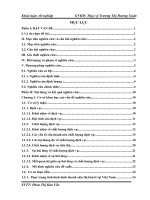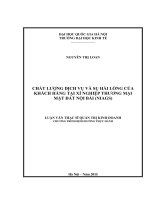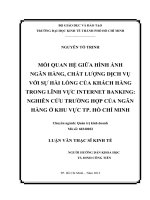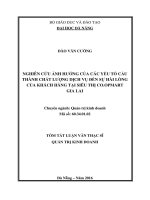- Trang chủ >>
- Văn bán pháp quy >>
- Báo cáo
ĐÁNH GIÁ CHẤT LƯỢNG DỊCH VỤ VÀ SỰ HÀI LÒNG CỦA KHÁCH HÀNG: NGHIÊN CỨU THỰC NGHIỆM TẠI SIÊU THỊ LAN CHI, THÁI NGUYÊN
Bạn đang xem bản rút gọn của tài liệu. Xem và tải ngay bản đầy đủ của tài liệu tại đây (1.01 MB, 10 trang )
<span class='text_page_counter'>(1)</span><div class='page_container' data-page=1>
<b>Tập 183, số 07, 2018</b>
Tập 183
, Số 07
</div>
<span class='text_page_counter'>(2)</span><div class='page_container' data-page=2>
<i> </i>
Tạp chí Khoa học và Công nghệ
CHUYÊN SAN KHOA HỌC XÃ HỘI – NHÂN VĂN – KINH TẾ
Môc lôc
Trang
Hồng Thị Phương Nga - Mơ hình du lịch văn học “Làng Vũ Đại ngày ấy” 3
<i>Phạm Thị Thu Hồi, Trần Thị Thanh - Tiếng lóng trong truyện về đề tài giáo dục của Văn Thành Lê </i>9
Ngô Thị Thanh Nga, Phạm Thị Hồng Vân - Vài nét về các phương thức thể hiện tình vợ chồng trong văn
học trung đại Việt Nam 15
Nguyễn Thị Thắm,Nguyễn Minh Sơn - Ý thức đối thoại của Nguyễn Ngọc Tư với văn học truyền thống thông
<i>qua những nhân vật nữ trong tập truyện Không ai qua sông </i> 21
Đặng Thị Thùy, Nguyễn Diệu Thương - Lơ gích của các hiện tượng “phi lơ gích” trong ca dao, tục ngữ
người Việt 27
Đinh Thị Giang - Những nhân tố ảnh hưởng đến lối sống của người Việt ở đồng bằng Bắc Bộ hiện nay 33
Nguyễn Diệu Thương, Nguyễn Thị Lan Hương - Phương thức tạo hàm ý trong tiểu phẩm trào phúng 39
<i>Nguyễn Thu Quỳnh, Vì Thị Hiền - Từ ngữ chỉ đồ gia dụng trong tiếng Thái ở tỉnh Điện Biên </i> 45
Nguyễn Thị Thu Oanh, Hoàng Thị Mỹ Hạnh - Vị thế, vai trò cầm quyền của Đảng Cộng Sản Việt Nam giai
đoạn 1945 - 1975 và một số bài học kinh nghiệm 51
Đỗ Hằng Nga, Phạm Quốc Tuấn - Việc thu thuế trong làng xã qua tư liệu hương ước cải lương tỉnh Thái Nguyên 57
Lê Văn Hiếu - Hiệu quả hoạt động của mô hình “ban tuyên vận” xã, phường, thị trấn và “tổ tuyên vận” thôn, bản, tổ
dân phố ở tỉnh Lào Cai trong giai đoạn hiện nay 63
Thái Hữu Linh, Nguyễn Thị Thu Hiền, Nguyễn Thị Thanh Hà - Vai trò của hậu phương Bắc Thái trong cuộc
tổng tiến công Mậu Thân năm 1968 69
Phạm Anh Nguyên - Sức hấp dẫn trong Hài đàm của Phan Khôi 73
Nguyễn Thị Hường, Nguyễn Thị Mão, Nguyễn Tuấn Anh - Nâng cao hiệu quả tổ chức các hoạt động ngoại
khoá trong dạy học môn giáo dục công dân ở các trường trung học phổ thông trên địa bàn thành phố Thái
Nguyên hiện nay 79
Nguyễn Văn Dũng, Đào Ngọc Anh - Thực trạng thể chất của sinh viên không chuyên thể dục thể thao Trường
Đại hoc Sư phạm – Đại học Thái Nguyên 85
Trần Bảo Ngọc, Lê Ngọc Uyển, Bùi Thanh Thủy và cs - Thực trạng xếp loại tốt nghiệp sinh viên diện cử
tuyển ở trường Đại học Y Dược – Đại học Thái Nguyên giai đoạn 2013-2017 91
Nguyễn Thúc Cảnh - Nghiên cứu xây dựng hệ thống bài tập có nội dung thực tế trong giảng dạy cơ học cho
học sinh trung học phổ thông 97
Hà Thị Kim Linh, Chu Thị Bích Huệ - Giáo dục kiến thức pháp luật cho phụ nữ vùng dân tộc thiểu số ở huyện
Võ Nhai, tỉnh Thái Nguyên 105
Nguyễn Thị Thanh Hồng, Nguyễn Thị Khánh Ly, Vũ Kiều Hạnh - Tăng cường sự tham gia của sinh viên
vào các hoạt động học tiếng Anh trong lớp học đơng nhiều trình độ của sinh viên năm thứ nhất trường Đại học
Y Dược – Đại học Thái Nguyên 111
Phạm Thị Huyền, Vũ Thị Thủy - Vận dụng phong cách nêu gương theo tư tưởng Hồ Chí Minh trong xây dựng
phong cách làm việc đối với cán bộ chủ chốt ở nước ta hiện nay 117
Đàm Quang Hưng - Thiết kế bài học khoa học lớp 4, lớp 5 theo hướng tìm tịi thực nghiệm 123
Hồng Thị Thu Hồi - Những khó khăn trong việc dạy và học từ vựng tiếng Anh chuyên cho sinh viên chuyên
ngành điều dưỡng, trường Cao đẳng Y tế Thái Nguyên và một số giải pháp đề xuất 129
Journal of Science and Technology
183
(07)
</div>
<span class='text_page_counter'>(3)</span><div class='page_container' data-page=3>
Nguyễn Lan Hương, Văn Thị Quỳnh Hoa - Những nhân tố ảnh hưởng đến khả năng nói tiếng Anh của sinh
viên năm thứ nhất trường Đại học Nông Lâm – Đại học Thái Nguyên 135
Vũ Kiều Hạnh - Những yếu tố quyết định đến mức độ đọc hiểu của sinh viên năm thứ hai tại trường Đại học
Nông Lâm – Đại học Thái Nguyên 141
Nguyễn Thị Quế, Hoàng Thị Nhung - Hỏi đúng để tự học và học tập cộng tác thành công – hướng tới xây
dựng người học ngoại ngữ độc lập trong bối cảnh hội nhập khu vực và quốc tế 147
Ngô Thị Thu Hà, Nguyễn Thị Hoài Thu - Ứng dụng các phương pháp giảng dạy tích cực nhằm nâng cao chất
lượng dạy – học tiếng Việt cho học viên quốc tế tại Học viện Kỹ thuật Quân sự 153
Dương Văn Tân - Đánh giá hiệu quả áp dụng trò chơi vận động trong phát triển thể lực chung cho sinh viên
trường Đại học Kỹ thuật Công nghiệp – Đại học Thái Nguyên 159
Bùi Thị Hương Giang - Nâng cao năng lực giao tiếp giao văn hóa trong dạy và học ngoại ngữ 165
Trần Hồng Tinh, Nơng La Duy, Phạm Văn Tn - Xây dựng trung đội tự quản trong quản lý giáo dục tính
kỷ luật cho sinh viên tại trung tâm giáo dục quốc phòng và an ninh trong giai đoạn hiện nay 171
Trần Thị Yến, Khổng Thị Thanh Huyền - Sử dụng hình thức đọc chuyên sâu để nâng cao khả năng viết học
thuật cho sinh viên chuyên ngành tiếng Anh 177
Đỗ Thị Hồng Hạnh, Hoàng Mai Phương - Đào tạo nghề cho lao động nông thôn trên địa bàn huyện Chợ Mới,
tỉnh Bắc Kạn 183
Trần Thùy Linh, Trần Lương Đức, Nguyễn Thị Thùy Trang - Cách tiếp cận của pháp luật cạnh tranh liên
minh châu Âu về hành vi lạm dụng mang tính trục lợi 189
Nguyễn Thị Thanh Hà, Phạm Việt Hương - Xây dựng bộ tiêu chí và chỉ số kinh tế phù hợp để đánh giá quản
lý rừng bền vững ở huyện Định Hóa 195
Đinh Thị Hồi - Truyền thơng marketing sản phẩm và dịch vụ thông tin - thư viện tại Trung tâm Học liệu Đại
học Thái Nguyên 201
Nguyễn Thị Thanh Xuân - Nghiên cứu nhân tố ảnh hưởng đến sự hài lòng của khách hàng sử dụng dịch vụ
khách sạn tại Thanh Hóa, Việt Nam 207
Dương Thị Tình - Đóng góp của xuất khẩu hàng hóa tới tăng trưởng kinh tế của tỉnh Yên Bái 213
Lê Minh Hải, Trần Viết Khanh - Phân tích tổ chức khơng gian lãnh thổ du lịch tỉnh Thái Nguyên 219
Hà Văn Vương - Vận dụng lý thuyết Ecgônômi trong tổ chức mơi trường làm việc tại văn phịng chi nhánh may
Sông Công II - Công ty Cổ phần Đầu tư và Thương mại TNG 227
Mai Anh Linh, Nguyễn Thị Minh Anh - Đánh giá chất lượng dịch vụ và sự hài lòng của khách hàng: nghiên
cứu thực nghiệm tại siêu thị Lan Chi, Thái Nguyên 233
Đinh Hồng Linh, Nguyễn Thu Nga, Nguyễn Thu Hằng - Sử dụng hàm Loga siêu việt để đánh giá hiệu quả
</div>
<span class='text_page_counter'>(4)</span><div class='page_container' data-page=4>
<i>Mai Anh Linh và Đtg </i> Tạp chí KHOA HỌC & CƠNG NGHỆ 183(07): 233 - 237
233
ASSESSING SERVICE QUALITY AND CUSTOMER SATISFACTION:
AN EMPIRICAL STUDY AT LAN CHI SUPERMARKET, THAI NGUYEN CITY
Mai Anh Linh*, Nguyen Thi Minh Anh
<i>TNU - International School </i>
SUMMARY
Service quality and customer satisfaction are very important concepts that companies must
understand in order to remain competitive in business and hence grow. It is very important for
companies to know how to measure these constructs from the consumers’ perspective in order to
better understand their needs and hence satisfy them. Service quality is considered very important
because it leads to higher customer satisfaction, profitability, reduced cost, customer loyalty and
retention. The main purpose of this study is to find out how consumers perceive service quality
and whether they are satisfied with the services offered by Lan Chi Supermarket in Thai Nguyen
City using SERVQUAL model. Overall service quality perceived by consumers was not
satisfactory meaning expectations exceeded perceptions and all the dimensions showed higher
expectations than perceptions of services.
<i>Keywords: SERVQUAL, Service quality, customer satisfaction, expectation, perception, Lan Chi </i>
<i>Supermarket. </i>
INTRODUCTION *
In service marketing literature, service quality
is generally defined as the overall assessment
of a service by the customers [1], or the extent
to which a service meets customer’s needs or
expectations. due to intense competition and
the hostility of environmental factors, service
quality has become a cornerstone marketing
strategy for companies. This highlights how
important improving service quality is to
organisations for their survival and growth
since it could help them tackle these
challenges they face in the competitive
markets. This means that service-based
companies are compelled to provide excellent
services to their customers in order to have a
sustainable competitive advantage.
In addition, service quality is mainly focused
on meeting the customer’s needs and also how
good the service offered meets the customer’s
expectation of it. It is however difficult
according to previous studies to measure
service quality because of its intangible nature
and also because it deals with expectations and
perceptions of consumers which is difficult as
well to determine due to the complexity of
human behaviour.
*
<i>Tel: 0978 543 876; Email: </i>
Thai Nguyen City is the center city of Thai
Nguyen Province-the central of the Northern
mountainous and midland region of Vietnam
in terms of politics and economy. Thai
Nguyen City has a population of more than
363 thousand with variety of ethnic groups
and abundant and diverse natural resources.
In recent years, there have been positive
changes in the socio-economy of the province
in general and the city on particular. Thanks
to the growth in production in all sectors, the
average income of the city has been
increasing over the years, hence, consumption
especially for normal product has been
witnessing an upward trend.
</div>
<span class='text_page_counter'>(5)</span><div class='page_container' data-page=5>
<i>Mai Anh Linh và Đtg </i> Tạp chí KHOA HỌC & CƠNG NGHỆ 183(07): 233 - 237
234
Naturally, the supermarket is market driven
and market responsive, its top concern is
increasing or at least maintaining the market
share in heightened competition with other
supermarket system in the city like Minh Cau,
Thanh Do, Ton Mui, etc. With the entry of
new players and multiple channels, customers
have become more discerning and less “loyal”
[2]. This makes it imperative that Lan Chi
provide best possible products and services to
ensure,customer satisfaction. Therefore,
customer satisfaction has become one of the
most significant factors for the overall
profitability of retail banking, hence, the
significant of this research.
LITERATURE REVIEW
This section presents the general discussion of
the literatures and studies on service quality
and service delivery with the focus on the
retail industry. Customers perceive the
relative inferiority or superiority of services
by comparing a firm’s actual performance
with their Service Quality and Customer
Satisfaction expectations. The retail industry,
like many other service industries, is facing
demanding customers, fierce competition,
new technologies, and other changing
economic variables [3]. Therefore, it is
imperative for Lan Chi Supermarket to
achieve customer satisfaction through service
excellence. In summary, the study revolves
around customer satisfaction and its related
factors as follow
Service <i>quality: </i> Service quality is
considered an important tool for a firm’s
struggle to differentiate itself from its
competitors [4]. The relevance of service
quality to companies is emphasized here
especially the fact that it offers a competitive
advantage to companies that strive to
improve it and hence bring customer
satisfaction. Service quality has received a
great deal of attention from both
academician and practitioners [5] and
services marketing literature service quality
is defined as the overall assessment of a
service by the customer.
<i>Tangibles: Tangibles are the appearance of </i>
the physical facilities, equipment, personnel
and communications materials [6]. Since
services are intangible, customers derive their
perception of service quality by comparing
the tangible associated with these services
provided. It is the appearance of the physical
facilities, equipment, personnel and
communication materials (uniforms,
equipment, and work areas on-site, etc).
<i>Reliability: Reliability is the ability to </i>
perform the promised service in a
dependable and accurate manner. The
service is performed correctly on the first
occasion, the accounting is correct, records
are up to date and schedules are kept [7].
Reliability is consistency in rendering the
service promised reliably and carefully [6].
The term includes correct technical
functioning (accessibility and availability)
and accuracy of service promises.
<i>Responsiveness: </i> Responsiveness is the
readiness and willingness of employees to
help customers by providing prompt timely
services, for example, mailing a transaction
slip immediately or setting up appointments
quickly [7]. This dimension emphasizes
attentiveness and promptness in dealing with
customer's requests, questions, complaints
and problems. Responsiveness is
communicated to customers by length of time
they have to wait for assistance, answers to
questions or attention to problems.
Assuarance: Assuarance is the information
that service providers have sufficient
knowledge and ability to do a good job.
Assurance is the knowledge, the attention and
skills shown by the employees that inspire
credibility and trust [6].
</div>
<span class='text_page_counter'>(6)</span><div class='page_container' data-page=6>
<i>Mai Anh Linh và Đtg </i> Tạp chí KHOA HỌC & CƠNG NGHỆ 183(07): 233 - 237
235
employees should be trained how to interact
with customers and their end-users.
<i>Demographic backgrounds: Arezou in 2008 </i>
reports finding from a survey which looked
into the impact of service quality and
customer demographic characteristics on its
satisfaction which are two retention relevant
elements that influence customers’ decisions
to stay with or leave their bank [8].
RESEARCH METHODOLOGY
Research design
The conceptual framework explains the
underlying process, which is applied to guide
this study. As discussed above, the
SERVQUAL model is suitable for measuring
service quality and customer satisfaction in
Lan Chi Supermarket offering retailing
services using the service quality dimensions
which are modified with the addition of
products. The same dimensions to measure
both service quality and customer satisfaction
were used because it is assumed that both are
related [7] and customer satisfaction is an
antecedent of service quality [5]. Customers
who received services from Lan Chi
supermarket were interviewed to determine
their expectation and perception. The results
were then analyzed to findout the gap
between expectation and perception and
perceived service quality of the supermatket.
Data collection
Primary data were collected by utilizing
questionnaire surveys on natural customers of
Lan Chi Supermarket. The questionnaire for
the survey will comprise of three parts; The
first and the second part of the questions are
the main parts of the questionnaire that
comprises of 24 questions each aimed at
finding the respondents’ opinions pertaining
to the expectations and perceptions of service
quality of Lan Chi Supermarket; the third part
aims to clarify the profiles of respondents.
Statistical treatment
In order to analyze primary data, the
following statistical treatments were utilized:
Frequency, percentage distribution will be
used to identify and determine the profile of
the respondents in terms of naute, size and
location of business.
SPSS is used for the analysis of the data.
Descriptive statistics mainly involving the
mean, standard deviation, skewness and
kurtosis in the data analysis.
Standard deviation seeks to measure the
average amount of variability in a set of
scores between values and measures.
To interpret the result, weighted means and
the 7-point Likert scale were utilized.
FINDINGS
Descriptive Analysis
The demographic profile of the respondents is
described as follows; males were 26.4% while
females were 73.6% much higher than males.
A majority of the respondents were married
forming 63.6%, followed by single, 33.1%
and other levels formed 3.3%. Most of the
respondents 52.3% claimed they spend
between 3,000,000VND to 5,000,000VND of
their income on consumer goods, followed by
25.8% who spend upto 3,000,000VND,
17.2% spend 5,000,000VND to
7,000,000VND and 4.7% spend above
7,000,000VND on consumer goods.
Reliability test
The internal consistency of the modified
SERVQUAL items was assessed by
computing the total reliability scale in Table 1.
The total reliability scale for the study is 0.91,
indicating an overall reliability value for the
study is substantial considering the fact that
the highest reliability that can be obtained is
1.0 and this is an indication that the items of
the six dimensions of SERVQUAL model are
<i>accepted for analysis. </i>
</div>
<span class='text_page_counter'>(7)</span><div class='page_container' data-page=7>
<i>Mai Anh Linh và Đtg </i> Tạp chí KHOA HỌC & CƠNG NGHỆ 183(07): 233 - 237
236
increases when an item is deleted it shows
that item is not genuine in that dimension.
Looking at the reliability coefficients of all
six dimensions on table, some dimensions
have coefficients slightly below 0.7, tangibles
(0.636) and responsiveness (0.694). This
could as a result that some items under each
dimension seemed too similar. The
dimension, Product had a very low reliability
coefficient, 0.434 and this could have been
because of the small number of items (2) used
in that dimension. Other dimensions,
reliability, assurance and empathy showed
coefficients higher than 0.7, meaning these
dimensions comprising of various items show
a true measure of service quality.
<i>Table 1. Reliability Coefficient </i>
Dimension
Cronbach
alpha for
dimension and if
item deleted
Tangibles (TA) 0.636
TA 1 0.603
TA 2 0.544
TA 3 0.513
TA 4 0.509
Reliability (RL) 0.831
RL1 0.783
RL2 0.805
RL3 0.802
RL4 0.778
RL5 0.815
Responsiveness 0.694
RN1 0.705
RN2 0.573
RN3 0.587
RN4 0.638
Assurance (AS) 0.76
AS1 0.678
AS2 0.717
AS3 0.674
AS4 0.738
Empathy (EM) 0.755
EM1 0.688
EM2 0.808
EM3 0.661
EM4 0.734
EM5 0.648
Product (PR) 0.434
PR1 -
PR2 -
Gap Analysis
Overall, the items with the highest
expectation scores were clean physical
environment (6.6225), good quality products
(6.4768), sincere interest in solving
customer’s problem (6.3576) and customer
feels safe in transactions with employees
(6.3046). However, these scores are not very
different from scores of other items and this
implies generally, consumers expect very
high from the office.
The items rated highest for actual service
perceived were, good quality products
(5.7616), enough variety of products
(5.7364), customer feels safe in transactions
with employees (5.6556) and possession of
modern equipments (5.2318). There is no so
much difference between the scores of
perceptions but are generally lower than
expectations.
The gap scores are the difference between the
perception and expectation scores with a
range of values from -6 to +6 and these gap
scores measure service quality and hence
customer satisfaction. The more perceptions
are close to expectations, the higher the
perceived level of quality. The largest gaps
scores were, clean physical environment
(1.3973), sincere interest in solving
customer’s problem (-1.3907), fulfilling their
promise they make to consumers (-1.2715)
and employees never too busy to respond to
customers’ requests (-1.1656).
</div>
<span class='text_page_counter'>(8)</span><div class='page_container' data-page=8>
<i>Mai Anh Linh và Đtg </i> Tạp chí KHOA HỌC & CƠNG NGHỆ 183(07): 233 - 237
237
To overcome this situation, Lan Chi
Supermarket should take measures such as the
placement of trash bins at convenient places,
rearranging the shelves in a scientific way to
ensure light and air circulation. Use more trees
to create a healthy environment and enhance
cleaning in the dining area. For employees,
supermarkets need to arrange reasonable shift
work, increase staff at peak time to reduce
work pressure. Moreover, the constant
education, training staff on the way and the
service attitude is extremely necessary.
REFERENCES
1. Eshghi, A. (2008), “Service quality and customer
satisfaction, An imperical investigation in India
<i>mobile Telecommunications services”, Marketing </i>
<i>Management Journal, 18(2), pp.119-144. </i>
2. Ankit, S. (2001), “Market research on factors
affecting customer satisfaction in retail banking in
<i>Vadodara, Gujarat, Western India”, International </i>
<i>Journal of Scientific & Technology Research, </i>
1(2).
3. Reichheld, F. F. and W. E. Sasser (1990),
“Zero defections: quality comes to services,
Harward Business Review”, September-October,
pp. 105-111.
4. Ghylin, K. M., Green, B. D., Drury, C. G.,
Chen, J., Schultz, J. L., Uggirala, A., Abraham, J.
K., & Lawson, T. A. (2008), “Clarifying the
dimensions of four concepts of quality”,
<i>Theoretical Issues in Ergonomics Science, 9(1), </i>
pp. 73-94.
5. Negi, R. (2009), “Determining customer
satisfaction through perceived service quality: A
<i>study of Ethiopian mobile users”, International </i>
<i>Journal of Mobile Marketing, 4(1), pp. 31-38. </i>
6. Salvador-Ferrer, C. M, (2010), “Quality of
University Services: Dimensional Structure of
<i>SERVQUAL VS. ESQS”, Service Science, </i>
<i>INFORMS, 2(3), pp. 167-176. </i>
7. Parasuraman, A., V. A. Zeithaml, and L. L.
Berry (1994), “Reassessment of expectations as a
comparison standard in measuring service quality:
<i>Implications for future research”, Journal of </i>
<i>Marketing, 58, pp. 111-124. </i>
8. Lee, H., Y. Lee, and D. Yoo. (2000), “The
determinants of perceived service quality and its
<i>relationship with satisfaction”, Journal of Service </i>
<i>Marketing, 14(3), pp. 217-231. </i>
TÓM TẮT
ĐÁNH GIÁ CHẤT LƯỢNG DỊCH VỤ VÀ SỰ HÀI LÒNG CỦA KHÁCH HÀNG:
NGHIÊN CỨU THỰC NGHIỆM TẠI SIÊU THỊ LAN CHI, THÁI NGUYÊN
Mai Anh Linh*, Nguyễn Thị Minh Anh
<i>Khoa Quốc tế - ĐH Thái Nguyên </i>
Chất lượng dịch vụ và sự hài lòng của khách hàng là những khái niệm rất quan trọng mà các doanh
nghiệp phải hiểu để duy trì tính cạnh tranh trong kinh doanh và do đó phát triển. Điều rất quan
trọng đối với các doanh nghiệp là biết cách đo lường các khái niệm này từ quan điểm của người
tiêu dùng để hiểu rõ hơn nhu cầu của họ và đáp ứng chúng. Mục đích chính của nghiên cứu này là
để tìm hiểu cách người tiêu dùng cảm nhận chất lượng dịch vụ và liệu họ có hài lịng với các dịch
vụ được cung cấp bởi Siêu thị Lan Chi tại thành phố Thái Nguyên hay khơng sử dụng mơ hình
SERVQUAL. Kết quả nghiên cứu cho thấy, nhìn chung, chất lượng dịch vụ của siêu thị được
người tiêu dùng cảm nhận là chưa đạt được kỳ vọng.
Từ khóa: <i>SERVQUAL, Chất lượng dịch vụ, sự hài lòng của khách hàng, kỳ vọng, cảm nhận, Siêu </i>
<i>thị Lan Chi</i>
<i>Ngày nhận bài: 05/6/2018; Ngày phản biện: 14/6/2018; Ngày duyệt đăng: 29/6/2018 </i>
*
</div>
<span class='text_page_counter'>(9)</span><div class='page_container' data-page=9>
<i>oµ </i>
<i>soT </i>
Tạp chí Khoa học và Công nghÖ
SOCIAL SCIENCE – HUMANITIES – ECONOMICS
Content
PageHoang Thi Phuong Nga - Literature tourism model “the old Vu Dai village” 3
<i>Pham Thi Thu Hoai, Tran Thi Thanh - Slang in Van Thanh Le's stories about education problems </i>9
Ngo Thi Thanh Nga, Pham Thi Hong Van - A brief description of the modes of expressing conjugal
sentiments in the Vietnam medieval literature 15
Nguyen Thi Tham, Nguyen Minh Son - The opposite view of Nguyen Ngoc Tu to Vietnamese traditional
<i>literature via the main female characters in Khong ai qua song </i> 21
Dang Thi Thuy, Nguyen Dieu Thuong - The logic of “non logic” phenomenon in Vietnamese folk verses, proverbs 27
Dinh Thi Giang - Factors affecting current lifestyle of Vietnamese people in the northern delta 33
Nguyen Dieu Thuong, Nguyen Thi Lan Huong - Mechanisms creating implication in satirical jokes 39
Nguyen Thu Quynh, Vi Thi Hien - Household vocabulary of Thai language in Dien Bien province 45
Nguyen Thi Thu Oanh, Hoang Thi My Hanh - Position, role of the communist party of Vietnam in the period
1954 – 1975 and some lessons learned 51
Do Hang Nga, Pham Quoc Tuan - Collection of taxes in the villages through material of reformist village
convention in Thai Nguyen province 57
Le Van Hieu - The efficiency of the model "propaganda department" in communes, wards, township and
"commander" in villages, cities at the current period in Lao Cai province 63
Thai Huu Linh, Nguyen Thi Thu Hien, Nguyen Thi Thanh Ha - The role of the rear Bac Thai in the 1968
general offensive 69
Pham Anh Nguyen - The attraction in “Hai dam” of Phan Khoi 73
Nguyen Thi Huong, Nguyen Thi Mao, Nguyen Tuan Anh - Enhancing the efficiency of extracurrucular
activities in teaching civic education at high schools in thai nguyen city these days 79
Nguyen Van Dung, Dao Ngoc Anh - Physical status of non-sports students at Thai Nguyen University of Education 85
Tran Bao Ngoc, Le Ngoc Uyen, Bui Thanh Thuy et al - The reality of degree classification in
non-examination students at University of Medicine and Pharmacy – Thai Nguyen University in the period from
2013 to 2017 91
Nguyen Thuc Canh - The need for buiding an exercise system with practical content to teach mechanics
to high school 97
Ha Thi Kim Linh, Chu Thi Bich Hue - Educate legal knowledge for ethnic minority women in Vo Nhai
district, Thai Nguyen province 105
Nguyen Thi Thanh Hong, Nguyen Thi Khanh Ly, Vu Kieu Hanh - Improve students’ participation in
English learning activities in large mixed ability classes of the freshman students at Thai Nguyen University of
<i>Medicine and Pharmacy </i> 111
Pham Thi Huyen, Vu Thi Thuy - Manipulate exemplary style according to the President Ho Chi Minh’s
thought in building work style for key caders at present period 117
Dam Quang Hung - Science lesson planning for grade 4, 5 according to experimental research 123
Hoang Thi Thu Hoai - Difficulties in teaching and learning ESP vocabulary for nursing students at Thai
Nguyen Medical College and some solutions 129
Nguyen Lan Huong, Van Thi Quynh Hoa - Determinants affecting English speaking performance of the
<i>first-year students at Thai Nguyen University of Agriculture and Forestry </i> 135
Journal of Science and Technology
183
(07)
</div>
<span class='text_page_counter'>(10)</span><div class='page_container' data-page=10>
Vu Kieu Hanh - Determinants to the reading comprehension performance level of the second- year students at
Thai Nguyen University of Agriculture and Forestry 141
Nguyen Thi Que, Hoang Thi Nhung - Asking the right question for successful self-studying and cooperative
learning - towards independent language learners in the context of ASEAN community and global integration 147
Ngo Thi Thu Ha, Nguyen Thi Hoai Thu - Apply interactive teaching methods to improve the quality of
teaching and learning Vietnamese to international students at Military Technical Academy 153
Duong Van Tan - An assessment of the effectiveness in application of games in general physical development
for students at Thai Nguyen University of Technology 159
Bui Thi Huong Giang - Improving intercultural communicative competence in foreign language teaching
<i>and learning </i> 165
Tran Hoang Tinh, Nong La Duy, Pham Van Tuan - Building self-managed platoon in disciplinary education
for students at the center for defense and security education in the current phase 171
Tran Thi Yen, Khong Thi Thanh Huyen - Improving academic writing performance for english majors
through intensive reading 177
Do Thi Hong Hanh, Hoang Mai Phuong - Vocational training for rural workers in Cho Moi district, Bac
Kan province 183
Tran Thuy Linh, Tran Luong Duc, Nguyen Thi Thuy Trang - European union competition law approach on
exploitative abuses 189
Nguyen Thi Thanh Ha, Pham Viet Huong - Setting up an appropriate set of economic criteria and indicators
for evaluating sustainable forest management in Dinh Hoa district 195
Dinh Thi Hoai - Marketing promotion for information - library product and service at the Learning Resource
Center of Thai Nguyen University 201
Nguyen Thi Thanh Xuan - Factors affecting customer satisfaction in hotels at Thanh Hoa province, Vietnam 207
Duong Thi Tinh - Contributions of goods export to the economic growth of Yen Bai province 213
Le Minh Hai, Tran Viet Khanh - Tourism space organization of Thai Nguyen province 219
Ha Van Vuong - Apply the ergonomics theory in working environment organization at the office of Song Cong
grarment branch II – TNG Investment and Trading Joint Stock Company 227
Mai Anh Linh, Nguyen Thi Minh Anh - Assessing service quality and customer satisfaction: an empirical
study at Lan Chi supermarket, Thai Nguyen city 233
Dinh Hong Linh, Nguyen Thu Nga, Nguyen Thu Hang - Applying logarithmic function to evaluate the
business efficiency of Vietnam banks 239
</div>
<!--links-->









